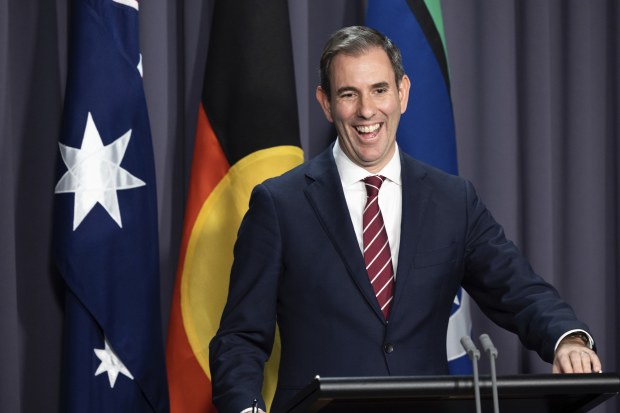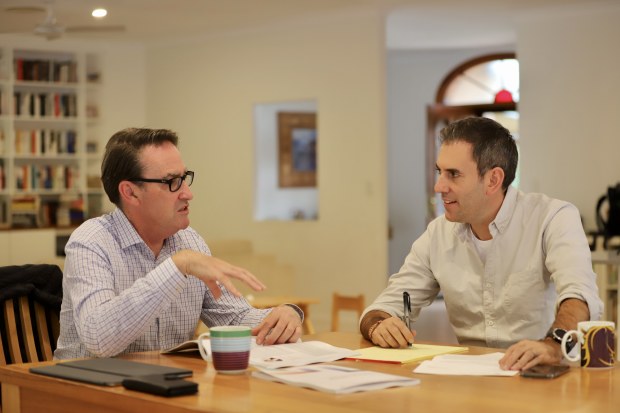Scott Treatt and Andrew Mills: Former ATO SESs now of The Tax Institute fame

Act on zombie tax and super measures, Treasurer urged

Urgent clarity is needed over dozens of outstanding tax and superannuation measures announced but not enacted by the former Morrison government and Jim Chalmers has been urged to think big on reform plans now Labor is in power.
The Tax Institute has presented the Treasurer with a list of proposals to streamline the tax system and spur economic growth, including moves to help business owners dealing with ongoing pressures from the COVID-19 pandemic.

The “incoming government brief” from The Tax Institute was handed to Treasurer Jim Chalmers Alex Ellinghausen
Zombie measures left unresolved from before the May 21 election include a complex draft guidance on division 7A of the Income Tax Assessment Act, and rules on licensing arrangements for a person’s fame or image.
The Tax Institute said some parts of division 7A plans announced by the Tax Office were among the highest priority measures for the new government. Court cases had resulted in “significant complexity and increased costs for taxpayers to comply with the rules”.
Action on corporate residency rules, the superannuation guarantee regime, the patent box regime and COVID-19 and natural disaster payments are among top priorities.
The brief says current laws are inconsistent regarding the treatment of various federal and state government small business support payments and emergency measures announced at the height of the pandemic.
Government grants related to the flood disaster in Queensland and NSW in early 2022 should be the subject of an enabling bill designed to stop recipients from being taxed on payments they have received, the brief said.
Call for action
It calls for action on the increased risk of business collapses, including risks from rising costs such as fuel and utilities, as well as widespread staff shortages.
The Tax Institute also said ongoing pressure on tax professionals and advisers was hurting their ability to effectively administer significant proposed system changes in the short term.
In February, the ATO announced a long-awaited draft ruling and practical compliance guidelines on payments from family trusts, in moves designed to limit “washing machine” cash distributions and tax-saving arrangements completed under the guise of ordinary family business.
Another high priority identified in the brief is the new small business skills and training boost measure announced in the March budget. It would enable eligible operators to claim an extra 20 per cent on the cost of training courses provided to workers.
Senior advocate Robyn Jacobson said that without legislative certainty about some key measures, there was a high risk that small businesses would withhold spending, exacerbating existing skill shortages and slowing the economic recovery.
Digital adoption
“The technology investment boost will support small businesses improve
their digital adoption, which would allow the Australian economy to keep pace with other developed countries,” she said.
“The government should commit to legislating the boosts in the first parliamentary session.”
The ATO’s debt book has increased by almost 78 per cent in the past four years, and the brief says there are no policies in place to address the repayment of existing tax debt and the prevention of future liabilities.
General manager of tax policy and advocacy at The Tax Institute, Scott Treatt, said employers were still struggling after more than two years of major disruption.
“The toll on their mental health has been significant and this factor should weigh heavily in determining the timing of future changes,” Mr Treatt said.
“The need for genuine and holistic tax reform remains crucial to Australia’s
future prosperity and its importance cannot be overstated or forgotten.”
Tom McIlroy reports from the federal press gallery at Parliament House. Connect with Tom on Twitter. Email Tom at thomas.mcilroy@afr.com
ATO TAX DEBT UP 78% IN FIVE YEARS
Dual income tax should be on Chalmers’ radar
A big, bold policy would be a flat tax of 25 per cent on personal capital income that would be simpler and more equitable than the current hotchpotch of tax breaks.
Treasury secretary Steven Kennedy this month began to gently outline potential budget overhaul opportunities on spending and taxation for the Albanese Labor government.
Treasurer Jim Chalmers in an interview with AFR Weekend opened the door to a national discussion, probably next year when he is armed with several economic reports, about more sustainable spending and revenue

Jim Chalmers, right, at his house in Logan with Treasury secretary Steven Kennedy.
The documents will include the Intergenerational Report that will show the 40-year spending pressures on the budget from big social welfare, defence and debt interest costs, a Productivity Commission five-year review and a Treasury tax expenditures statement that will be more transparent about the costs to future generations of tax breaks.
Sensibly, Kennedy warned against relying on ever-rising average income tax rates on wage earners through stealth bracket creep caused by increasing wages and inflation. Bravo. That should rule out further lazy income tax “levies” to fund the National Disability Insurance Scheme, aged care and health.
The Treasury boss turned to the generosity of tax breaks – such as from superannuation, capital gains on shares and housing, interest, dividends, rent and trusts.
Now, here is a big, bold idea.
A significant tax reform that could achieve more productive and fairer taxation is a “dual income tax system” used in Nordic countries that splits income and deductions into two components: labour and capital/savings.
It would be a very Labor reform that could assist hard-working wage earners, while delivering fairness and efficiency.
After delivering his first budget on October 25, Chalmers should seriously consider a dual income tax system in the second half of this government term to take to the next election.
It would be a very Labor reform that could assist hard-working wage earners, while delivering fairness and efficiency.
A flat tax rate of, say, 25 per cent on personal capital income and deductions would be a simpler and more equitable system than the current hotchpotch of concessions and distortions. It would help eradicate the “tax planning” Kennedy lamented.
Currently, a property investor has their capital gains taxed at half their marginal tax rate. For a high-income earner, that equals a top tax rate of 23.5 per cent. But they can fully deduct at a rate of 47 per cent their interest and other property expenses, including against wages and salary. It is an asymmetric arbitrage that makes little sense.
Meanwhile, a simple saver pays a punishing rate of up to 47 per cent on bank interest, with no deductions.
Uniform rate across personal capital income
While there are legitimate asset protection reasons for trusts, they allow streaming of income to beneficiaries to minimise tax for the families of well-heeled people who can afford clever tax accountants and lawyers.
The dual income tax system would ring-fence investment income and deductions at a flat tax rate of perhaps 25 per cent.
Investment losses would be carried forward to offset against future capital income, not immediately or fully deductible against wages.
It may be possible to deduct a portion against wages and salaries, but only the dollar amount determined by a flat 25 per cent capital income rate.
A uniform rate across all personal capital income would slash tax-driven distortions.
Otherwise, selectively picking off individual tax breaks without a comprehensive approach just leads to tax planners shifting to remaining loopholes.
Over time, a dual income tax system would give the government more fiscal capacity to cut income taxes for wage and salary earners and stop bracket creep hitting a record high of more than 26 per cent by 2030, as Kennedy’s analysis shows.
The Australian Taxation Office’s world-class single touch payroll system would also make it easier to distinguish between labour and capital income.
Income tax cuts would be limited to wage and salary earners, and not flow through to tax breaks on capital income. It would be more affordable for the budget.
For years, the Coalition government leaked billions of dollars of tax refunds for “unearned” or passive investment income through the $8 billion annual low and middle income tax offset.
Moreover, at a time of worker shortages, alleviating the tax burden on wage earners would increase the incentive to work more hours and aid workforce participation.
Chance to recalibrate stage three tax cuts
There may also be an opportunity to recalibrate – not cancel – the $15 billion-a-year stage three personal income tax cuts due from July 2024, to get maximum bang for buck.
Perhaps the tax cuts for high-income earners could be partly traded off for clamping down on other concessions on superannuation and capital income.
Longer-term, a dual income tax system may present an opportunity to lower the top personal income tax rate for labour income closer to the capital income rates and the 30 per cent corporate rate.
This would further slash tax arbitrage through companies and trusts.
Former Labor prime minister and treasurer Paul Keating has consistently advocated cutting marginal tax rates, including the maximum 47 per cent rate (counting the Medicare levy) that kicks in at a $180,000 a year.
By international standards, the top threshold applies to relatively modest incomes for wage earners living in high-cost Sydney and Melbourne who are trying to pay a mortgage or rent and raise children.
A simpler tax system and more uniform rates would reduce Australia’s high dependence on tax agents. More than 70 per cent of taxpayers use a tax agent to file tax returns, even though 86 per cent either claim no deductions or claim only work-related expenses, gifts and the costs of managing tax affairs.
In Nordic countries, less than 5 per cent of taxpayers use tax agents.
Australia’s human capital pool would be enhanced by having fewer well-educated tax lawyers and accountants, and diverting these smart people into more innovative and productive engineering, technology and science professions.
Australia National University economists Robert Breunig and Kristen Sobeck have advocated the dual income tax system to apply a uniform tax rate to most savings. They argue the rate on savings should be low – between 5 and 20 per cent – because savings have usually already been taxed as wages. They also suggest taxing the principal place of residence, although this would be politically very difficult.
The 2010 tax review by former Treasury secretary Ken Henry recommended taxing remuneration for work, including wages, salaries, fringe benefits and employer superannuation contributions, “in a more consistent manner and with few exemptions”.
“Income from savings would be taxed on a more consistent basis with other income.”
Chalmers is the government’s best public communicator. He might have the ability to connect with the community and sell economic reforms like Keating.
Chalmers is taking a medium-term view and not rushing to offer counterproductive Band-Aid solutions to cost of living pressures and the energy crisis.
He has learnt the follies of trying to win the daily media battles from his time working as a senior adviser in the Rudd-Gillard governments.
Let’s hope genuine tax reform comes on to his agenda.
John Kehoe is Economics editor at Parliament House, Canberra. He writes on economics, politics and business. John was Washington correspondent covering Donald Trump’s election. He joined the Financial Review in 2008 from Treasury. Connect with John on Twitter. Email John at jkehoe@afr.co


